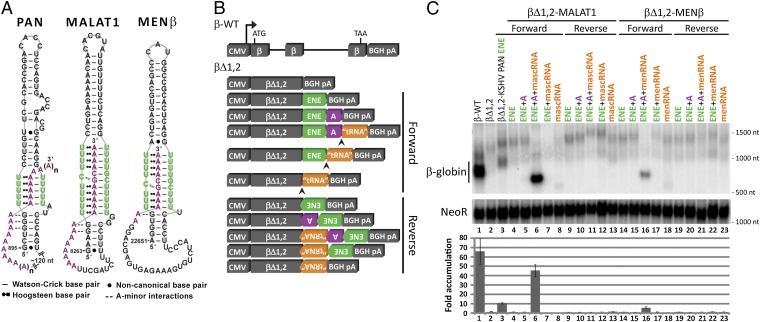Fig. 1.
Models and stabilization activity of the predicted cellular ENE-like structures. (A) Schematic diagrams for the predicted ENE-like structures from MALAT1 (nucleotides 8263–8355) and MENβ (nucleotides 22651–22743) RNAs are based upon the known secondary and tertiary contacts of the PAN ENE (nucleotides 895–959) (14, 15). Nucleotides in the U-rich internal loop are in green and nucleotides in the poly(A) tail and A-rich tract are in purple. (B) Schematic diagrams of the β-globin plasmid constructs with different combinations of the predicted cellular ENE (green), A-rich tract (purple), and tRNA-like sequence (orange, representing mascRNA or menRNA) from MALAT1 or MENβ in either the forward or reverse orientation (see Fig. S2 for construct details). β-Globin expression is driven by the CMV promoter; the RNase P cleavage site is indicated by an arrowhead; and there is a bovine growth hormone polyadenylation signal (BGH pA) downstream of the 3′ UTR. (C) Northern blots (Upper) were probed for β-globin and Neomycin resistance (NeoR) RNAs, with the βΔ1,2-KSHV PAN ENE (βΔ1,2–79F in ref. 12) included as a control. RNA sizes are indicated to the right of the blot. Results were quantitated (Lower) by normalizing the β-globin signal to the NeoR signal, which served as a loading and transfection control. The empty βΔ1,2 reporter level was set at an arbitrary value of 1. Fold-accumulation is the average of at least three independent experiments; error bars represent SD.

